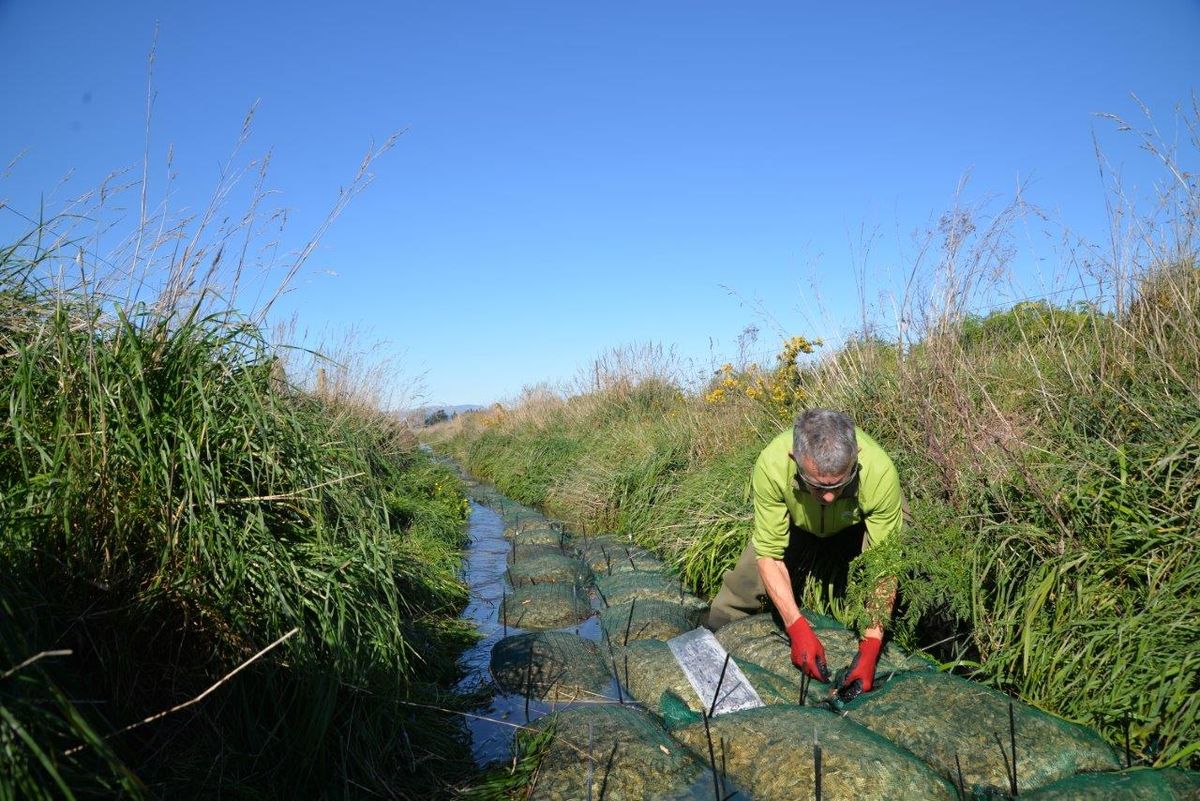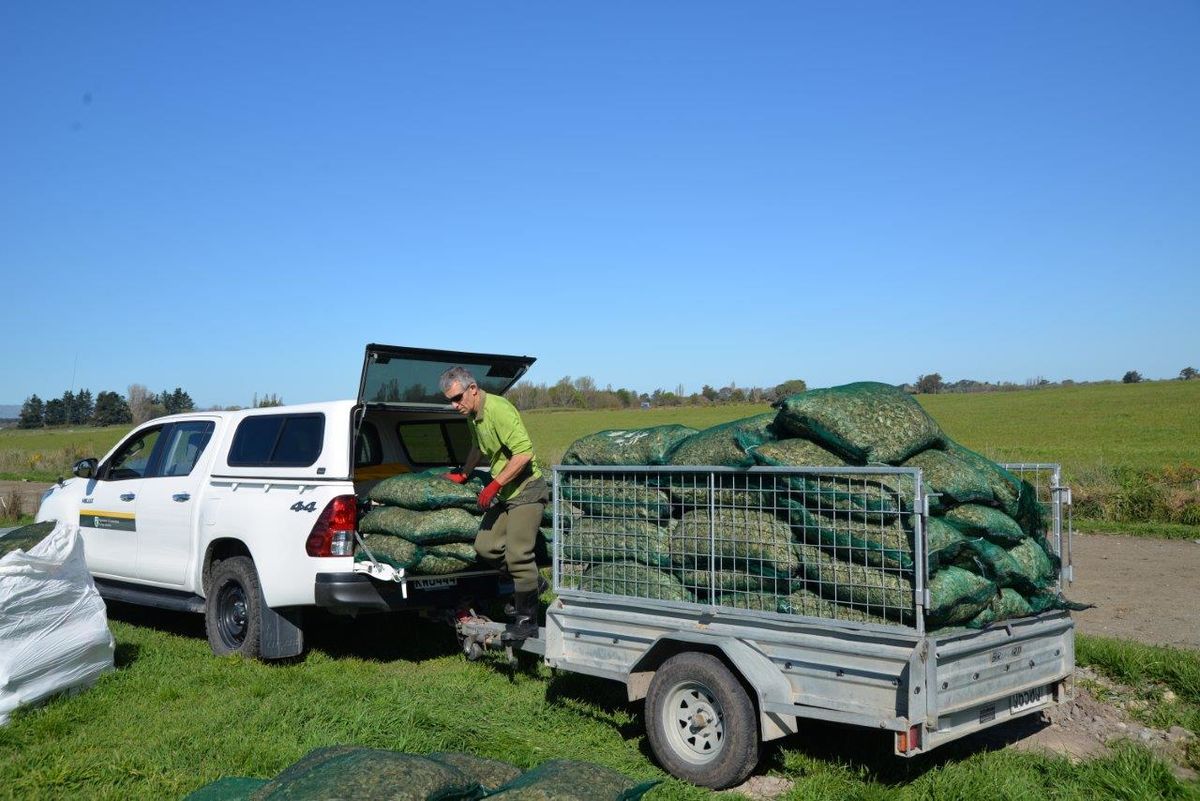
Bioreactor trial: reducing nitrates
What is the problem?
Two years of water sampling in the Ararira/LII catchment, a tributary of Te Waihora/Lake Ellesmere, carried out by the University of Canterbury’s Freshwater Ecology Research Group (CAREX) recorded high levels of nitrate-nitrogen within some of the catchment's waterways.
High levels of nitrates are harmful to human health, contribute to excessive aquatic weed growth and algal blooms and can be toxic to some fish and invertebrates. In the Ararira catchment, the nitrate comes mostly from groundwater arising as springs that flow into the drainage network and into Te Waihora/Lake Ellesmere.
Due to the loss of freshwater habitat on the Canterbury Plains, these spring-fed drains now make up most of the available habitat for our threatened freshwater fish species like inanga, upland and common bullies and longfin and shortfin tuna/eels.
What is the project?
In August-September 2020 an instream wood-chip bioreactor was installed in an on-farm spring-fed waterway that is dry over the Summer months. The aim was to trial a potential solution for reducing high nitrate levels as close as possible to the spring water source where groundwater becomes surface water.
What was done?
The bioreactor is part of a treatment-train which consisted of a 15m long sediment trap upstream of the bioreactor and a 720m long two-stage planted channel downstream of the bioreactor.
The instream bioreactor stretches 127 metres along an on-farm drain and is made of mesh bags filled with a total of 30 cubic metres of untreated pine woodchips. The bags were tied together and submerged allowing the water to flow slowly through the woodchips. The bioreactor is part of a treatment-train which consisted of a 15m long sediment trap upstream of the bioreactor and a 720m long two-stage planted channel downstream of the bioreactor.
The wood chips are colonised by microbes which, in low oxygen conditions, convert nitrate to nitrogen gas through a process called denitrification. This is a natural process that occurs in anoxic (oxygen depleted) environments such as wetlands. The nitrogen is released harmlessly back to the earth’s atmosphere which is made up of approximately 78% nitrogen

Robin Smith

DR JON HARDING

How much does it cost?
The wood-chip bioreactor was a relatively low-cost trial with expenditure incurred for the pine wood-chips, synthetic bags, materials transport, excavator time for re-shaping the waterway banks, resource consent, labour to install the bags and lab costs for water sampling.
Cost breakdown (gst exclusive):
- Wood chips (30m3), bags, transport - $6,670
- Excavator to reshape 127m banks (both sides) – $20/metre
- Lab water sampling - $536
- Canterbury Regional Council resource consent – consent for the bioreactor was incorporated into a package of works at 7 sites which totaled $11,800. The cost of the bioreactor consent is therefore difficult to estimate but if consent was sought solely for the bioreactor it could cost in the vicinity of $6,000 to $7,000
- Bank planting both sides – $33/metre - 4 rows of plants as well as site preparation (pre-plant spraying), planting, plant guards and fertilizer tablets (not included is 3 years of maintenance spraying during plant establishment)
The time taken for wood-chip bag installation and water sampling have not been included as these costs were met by Living Water and University of Canterbury staff (bag installation took about 3 days for 2 people).
What did Living Water learn from this trial?
The instream bioreactor was installed in August 2020 and was operational from August to October 2020 and from June to November 2021. The waterway where the bioreactor is situated is spring-fed and only flows from early winter to spring. Pasture irrigation using groundwater usually starts in September/October in Canterbury and on the farm where the bioreactor is located this results in the spring flow stopping.
Covid-19 lock-downs affected the gathering of water samples in 2020 and 2021. Four sampling rounds (June, July, September and November) were possible in 2021 and the results of those samples are shown in the table below.

Although the concentration of nitrate nitrogen in the water samples gradually declined from 15.8 mg/litre in June to just over 9 mg/litre in November, this drop cannot be attributed to the effect of the bioreactor as the upstream and downstream samples had similar levels of nitrate nitrogen. This decline is likely to be a natural drop in nitrate nitrogen evident throughout the spring period when the springs are active on the farm.
The 4 rounds of samples show no appreciative difference between the samples taken just upstream of the bioreactor and those taken downstream of the bioreactor. There are probably many reasons why the bioreactor isn’t performing as expected and these include:
- Not enough of the water passes through the wood chip bags for denitrification to have a measurable impact
- Water is not resident in the wood chip bags for long enough to allow denitrification to occur (i.e. the average flow of approximately 50 litres/second is too much)
- There are insufficient wood chips
- The presence of oxygen producing algae in the water may be increasing the dissolved oxygen and affecting the denitrification process which relies on anoxic conditions
- The intermittent nature of the waterway and the summer dry period may reduce the effectiveness of the bioreactor
- Water sampling is too infrequent to pick up fluctuations in nitrate
- The treatment train (sediment trap, bioreactor and two-stage channel) may take time to work effectively, especially as the plants in the two-stage channel will take several years to mature allowing a buildup of organic matter
It’s important to note the best way to reduce nitrates in ground water is to reduce nitrate losses into the soil. Changes made to farm management practices today (e.g. reducing nitrogen fertiliser use) might take decades to show up in reduced nitrate concentrations in ground water, as it takes ground water a long time to travel through the gravels of the Canterbury Plains.
Bioreactors have proven to be effective at other sites in New Zealand, but these have generally been where ground water or sub-surface drains have been intercepted to ensure that as much water as possible passed slowly through the wood chips.
If successful, bioreactors could be used across the country as a cost-effective, low maintenance intervention to reduce nitrates. Previous research by the University of Canterbury has indicated that an installed bioreactor could work for up to 10 years before needing to be replaced.
Who could use this information?
Landowners, Regional Councils, Land Managers, catchment managers in areas where high nitrates are a problem.
Links to other resources
CAREX’s toolbox to address water quality issues
More information on bioreactors:
